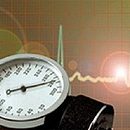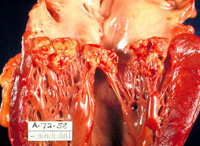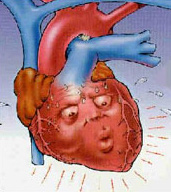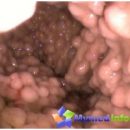The main method of diagnosing hypertrophic cardiomyopathy is EchoCG, during which, with maximum accuracy, it is possible to establish the severity of changes in myocardium. Treatment is aimed at improving the blood flow of the ventricles of the heart in diastole.
Content
Methods for diagnosing hypertrophic cardiomyopathy
 With auscultation (listening) of the heart in patients with obstructive form, systolic noise, the severity of which is proportional to the degree of obstruction is usually listened. According to the ECG data, signs of hypertrophy of the myocardial of the ventricles of the heart. ECG record for days (Halter monitoring) helps to identify existing heart rhythm disorders. ECG sample with dosage physical activity with a bicycle gamerhometer (special bicycle modification) or Tredmila («Running track») Allows you to assess the severity of the symptoms of the disease, its forecast and recommend appropriate treatment.
With auscultation (listening) of the heart in patients with obstructive form, systolic noise, the severity of which is proportional to the degree of obstruction is usually listened. According to the ECG data, signs of hypertrophy of the myocardial of the ventricles of the heart. ECG record for days (Halter monitoring) helps to identify existing heart rhythm disorders. ECG sample with dosage physical activity with a bicycle gamerhometer (special bicycle modification) or Tredmila («Running track») Allows you to assess the severity of the symptoms of the disease, its forecast and recommend appropriate treatment.
Echocardiography - the main method of diagnosing hypertrophic cardiomyopathy, allowing you to clarify the anatomical features of the disease, the severity of myocardial hypertrophy, the degree of obstruction of the output path of the left ventricle. Echocardiography is a decisive study in determining treatment tactics. Heart probing is a surgical method used in controversial cases, as well as when preparing patients with surgery. Heart probing under X-ray-television control. Technically, the method is performed by puncture (puncture) of a large artery under local anesthesia with the further introduction of a special catheter in the cavity of the heart. The gradient (difference) of the pressure between the left ventricle and the largest arteries of the body - aorta is measured (difference). In the norm of this gradient should not be. Also during the sounding of the heart, a contrast agent in the ventricular cavity (ventriculography) is introduced to study the features of its anatomy. In a number of patients, usually over 40 years old, before surgery for the heart simultaneously perform angiography of coronary arteries (coronoagography) to clarify the causes of the angina and the exclusion of the concomitant IBS.
Principles of treatment of hypertrophic cardiomyopathy
The basis of drug treatment is drugs, allowing to improve blood circular blood circular in diastole. These drugs are a group β-adrenoblockers (anaprilin, atenolol, metoprolol, etc.) and calcium ion antagonists group (Verapamil drug). In addition to the above task, these drugs also reduce the heart rate, possess an antiarrhythmic effect. At the beginning of treatment, small doses of these drugs are prescribed, gradually increasing the dosage to the maximum tolerable patient. The final dosage can sometimes exceed the initial several times. Beta adrenobloclars are used with caution or not apply in general during diabetes, bronchial asthma and a number of other diseases. If there are contraindications to the use of beta-adrenoblastors, verapamil is prescribed. During treatment with the above preparations require constant control of blood pressure and pulse frequency.
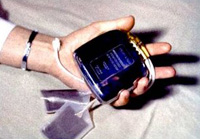 Dangerous is the decrease in blood pressure below 90/60 mm. RT. Art. and pulse frequency below 55 per minute. If the patient has hazardous rhythm disorders, non-treatment of beta-adrenoblasts or calcium ion antagonists, such patients are additionally prescribed by other antiarrhythmic drugs.
Dangerous is the decrease in blood pressure below 90/60 mm. RT. Art. and pulse frequency below 55 per minute. If the patient has hazardous rhythm disorders, non-treatment of beta-adrenoblasts or calcium ion antagonists, such patients are additionally prescribed by other antiarrhythmic drugs.
In the presence of thrombus in the chambers of the heart, anticoagulants are prescribed to the main treatment - preventing the formation of blood thromboms (warfarin, etc.). During treatment with these drugs, regularly monitor the row of blood coagulation indicators. Under the overdose of anticoagulants, outdoor (nasal, uterine, etc.) and internal bleeding (hematoma and others.). Surgical treatment is carried out by patients with obstructive form of the disease in the event of the ineffectiveness of drug treatment or at the gradient level between the left ventricle and the aorta more than 30 mm.RT.Art. (according to the sensing of the heart). The operation lies in the excision or removal of the part of the hypertrophied myocardium of the left ventricle. It should also be noted that all patients, especially with the obstructive form of the disease, are contraindicated with classes of sports, in which a significant increase in physical activity is possible in a short period of time (athletics, football, hockey and t.D.).
Prevention of the disease
The prevention of the disease is to identify it in the early stages, which allows you to start early treatment of the disease and prevent the development of severe myocardial hypertrophy. Echocardiography must be fulfilled at mandatory «blood» (genetic) relatives of the patient. All other persons showed a detailed examination in the presence of similarity of manifestations: fainting, angina and t.D. Also useful screening (all in a row) ECG and echocardiography during annual clinical examination. In patients with obstructive form of hypertrophic cardiomyopathy, it is also necessary to carry out the prevention of infectious endocarditis (antibiotic pyrofilax.D.), since the presence of obstruction creates the conditions for the development of this dangerous disease.

